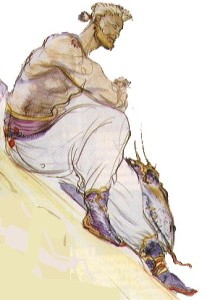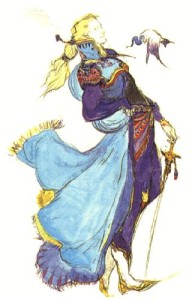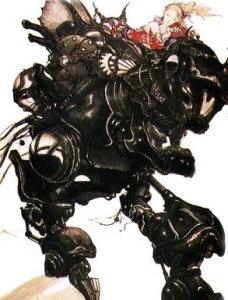4. Sabin
Sabin was not a character I readily related to. A “jock” with a relatively simple design, he was the first character in the game to whom I reacted, “meh.” So I was surprised at how exciting and inspiring his solo-mission became.
Separated from his friends by the hilariously nefarious octopus Ultros, Sabin has to make his way home alone. But he says “nah” to that and quickly makes friends (of a sort) with the stereotypically aloof loner, Shadow the ninja. Shortly thereafter he meets an entirely different companion: the stodgy and chivalrous knight, Cyan. In typical hero fashion, Sabin helps Cyan first, then offers to work together with him to accomplish similar goals. More different still was the wild child Gau, whom Sabin clearly does not like but is still willing to work with in order to achieve complimentary desires. It was this last pairing that helped me realize just how much Sabin’s personality and communication tools alter depending on who is speaking with him.
With the taciturn* Shadow, Sabin speaks rarely and mostly in soliloquy format: relaying information and considering strategies. With the stuffy and overzealous Cyan, Sabin transforms into a master dead-panner, comforting him in times of trouble and undercutting him in times of pomposity. We then see a complete reversal with Gau: Sabin is the one constantly being worked up, losing his temper, and displaying recurrent frustration with his inability to effectively communicate.
Communication is not my strength. At all. So it’s still taking some time for this lesson to gestate. Even so, Sabin showed me how interacting with new people and communicating using their frames of reference could not only help you achieve your own goals as well as theirs, but also make your journey to those goals richer and more varied.
*”Taciturn.” I learned this word from FF6. Thank you, Ultros.
Also he suplexes the Ghost Train.
5. Edgar
Probably the most popular male hero in FF6, King Edgar is Square’s answer to Tony Stark: millionaire playboy who’s great with machines. Similarly, Edgar’s attitude toward women is getting very outdated and awkward (though by no means is he anywhere near as bad as FF9’s super-creep Zidane), but he did still radiate an admirable aura of confidence both in social interactions and in decision-making.
Edgar does not possess his brother’s gift of altering his communication tools to fit each situation, but arguably his position of power allows him to forego such strategies. It’s a weakness, but there’s no question that he, like powerful thinkers and clever swashbucklers, always has his plans made out well ahead of time, allowing him to bulldoze or sidestep obstacles reliably. Sabin’s improvisational skills are admirable, but with Edgar they’re simply not necessary.
To some little extent, I often find myself in leadership roles nowadays: I teach students acting techniques, I produce and organize shows, and I often work as a director and playwright. From Edgar, I learned that a frank appraisal of one’s own worth, followed by augmentation of the merits and reparation of the flaws, is integral to commanding the respect of others. I also learned that you should always use the Drill instead of the Chainsaw against bosses and death-proof enemies.
That was the other cool thing about Edgar: he had special abilities that were always useful. It was a long time before the value of that quality sunk into my head, but I certainly get it now. I am remarkably fortunate that Unrehearsed Shakespeare is something in which I am so consistently interested and invested, as its uniqueness has allowed me numerous opportunities that other people do not get. And while I certainly worked hard over many years to develop that passion into tangible skills, and I’ve certainly done my fair share of networking, I still recognize how fortunate I was to have been in the right places and times with the right mindset to have reaped the benefits of my own unique skills.
6. Terra
Just like everyone else, Terra had no say in who her parents were, where she came from, or what sort of hell she would inherit just by being born. She spends the first half of FF6 letting things happen to her, literally being controlled by conflicting outside forces. She is controlled by Kefka and the Imperial forces (literally, via mind control). She is controlled (more gently, and via game mechanics) by the rebellious Returner forces. She is controlled (literally put “out of control”) by her biological status as a half-human-half-esper.
The second example above deserves exoneration: the game itself forces you to give the Returners what they want (of course, you can always choose to stop playing the game, as has been brilliantly illustrated by the recent masterpiece Undertale). In the plot of the game, however, the Returners are very much the opposite of the Empire. They inform Terra as much as possible about her reality and theirs, then offer her the choice of helping them or not. By direct contrast, Kefka and the Empire not only keep Terra entirely ignorant to the point of removing all memory of her former life, they even remove her ability to control her own physical actions. This is then mirrored in the third example of helplessness, where Terra’s ignorance of her own past keeps her from controlling her newfound abilities. In each case, the amount of available information is what controls the level of agency Terra possesses. Her lack of information, its late introduction in her life, and her sense of responsibility for actions long-past and outside her realm of control paralyze her and, once again, prevent her from taking agency over her own life.
In the second half of the game, Terra takes control by granting agency to others, by empowering others. Though ostensibly a “purpose through motherhood” cliche, Terra’s choice to take a hand in the raising (and education) of several orphans reflects (I think) a desire to empower others and give them the control she did not have in her own youth.
That is perhaps the most inspiring thing about Terra (except for that rockin’ intro sequence on the Magitek armor): she has no desire for revenge, she only wants to understand. Once she understands, she wants to give that power to other people.
Final Fantasy 6 was at once a pastoral and epic experience for me, and a badly needed dose of escapism. The lessons and inspirations I took from it were a hugely positive influence on a young little life, and I’m still benefiting from it today.




